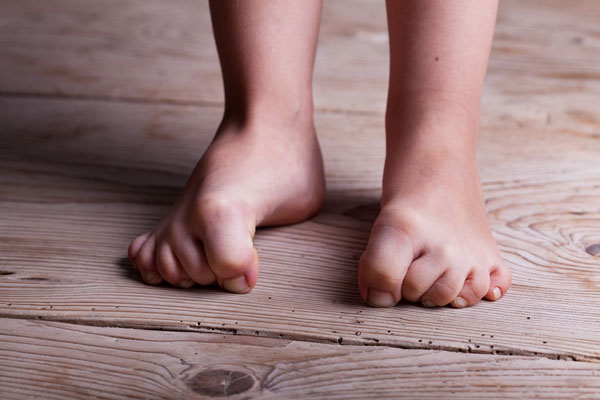In-toeing Gait
Did you ever notice that your child falls over more frequently? Fall overs are common during the growth years. But if it is more frequent, it might be due to an inward gait. Continue to read this article to learn more about the inward gait.
What is intoeing gait?
In-toeing gait, or pigeon-toed gait, is a condition in which the feet turn inward instead of pointing straight when the child walks or runs. It is the most common rotational deformity among young children. In-toeing usually affects both feet, but in some children, only one foot may be affected.

What are the symptoms of intoeing gait?
In-toeing gait is not associated with pain, nor does it develop into arthritis. It appears worse when the child runs, causing them to get tired very easily. However, falling is not related to in-toeing gait but is a part of the normal process of learning to walk.
What are the causes and risk factors of intoeing gait?
Intoeing gait mainly occurs due to three conditions as described below:
- Metatarsus adducts (inward turning of the foot or curved foot): This is a common deformity that occurs in many infants and is believed to be due to the curved positioning of the baby in the womb. Some cases are mild and flexible, while others are severe and rigid.
- Tibial torsion (inward turning of the shinbone): It occurs usually before birth due to the limited space in the womb, which can cause the lower legs to rotate and fit in the womb.
- Femoral anteversion (inward turning of the thighbone or femur): It is the most common cause of in-toeing gait, usually evident among children aged between 2 and 4 years. A normal child has 40 degrees of femoral anteversion, which gradually decreases as the child grows. If the angle is higher than this, it can lead to an inward gait. Children with this condition prefer sitting in the W position with their knees bent and their feet flared out behind them.
The above conditions can develop on their own or may result from other orthopedic problems. Additionally, having a family history of in-toeing gait increases its risk in children.
How is intoeing gait diagnosed?
An in-toeing gait is usually noticed at first by the parents when the child starts walking. The pediatric orthopedician (a specialist in treating bone abnormalities) can determine whether the problem is coming from the hips, legs, or feet.
Initially, a thorough physical examination is done to check the degree of rotational abnormality, shape, and direction of the sole, etc. A physical examination usually provides sufficient information to plan the treatment. However, imaging tests may be needed in patients with significant rotational deformity and hip dislocation. Computed tomography (CT scan) is the best method to evaluate femoral anteversion and is used in cases of complex hip deformity. Other imaging techniques that may be used include plain X-rays, fluoroscopy, and ultrasonography.
What are the treatment options?
Usually, treatment is not necessary; only simple reassurance and observation are enough. Most children with an in-toeing gait will develop a normal gait by the age of 8 years, even without the use of casts, braces, surgery, or any other specific treatment.
- The use of special shoes, bracing or splinting, and exercises is not beneficial in cases of in-toeing associated with femoral anteversion and tibial torsion. It is advisable to use properly fitting shoes as a corrective measure for in-toeing gait associated with metatarsal adducts.
- As the child gets older, engaging in activities such as out-toed walking or walking along a straight line, which helps to strengthen the hips, can be helpful.
- Out-toed activities such as horseback riding, ballet dance, swimming breaststroke, and martial arts may be helpful.
- The child should be encouraged to sit cross-legged instead of the frequent 'W sit' to stretch the hip if it is comfortable for them to do so.
Surgery
Surgery is indicated in the following conditions:
- Femoral anteversion if more than 45 degrees
- When the hip cannot be rotated laterally beyond the neutral
- When there is a functional disability or severe cosmetic deformity
De-rotational femoral osteotomy is the surgical correction for femoral anteversion, which involves cutting the femur and rotating it until it is properly aligned. It is not considered for children under the age of 9 to 10 years due to the high chances of spontaneous correction before this age.
What are the preventive measures for intoeing gait
In-toeing gait results from genetic or developmental problems. Therefore, it is not possible to prevent this condition.